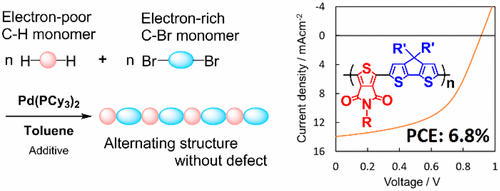当前位置:
X-MOL 学术
›
Macromolecules
›
论文详情
Our official English website, www.x-mol.net, welcomes your
feedback! (Note: you will need to create a separate account there.)
Suppression of Homocoupling Side Reactions in Direct Arylation Polycondensation for Producing High Performance OPV Materials
Macromolecules ( IF 5.1 ) Pub Date : 2016-12-15 00:00:00 , DOI: 10.1021/acs.macromol.6b02380
Junpei Kuwabara 1 , Yohei Fujie 1 , Keisuke Maruyama 1 , Takeshi Yasuda 2 , Takaki Kanbara 1
Macromolecules ( IF 5.1 ) Pub Date : 2016-12-15 00:00:00 , DOI: 10.1021/acs.macromol.6b02380
Junpei Kuwabara 1 , Yohei Fujie 1 , Keisuke Maruyama 1 , Takeshi Yasuda 2 , Takaki Kanbara 1
Affiliation

|
Suppression of side reactions in C–H direct arylation polycondensation is important for developing this method as a reliable synthetic tool for conjugated polymer materials. To find appropriate reaction conditions for avoiding homocoupling side reactions, two types of reaction conditions were investigated: the direct arylation of electron-rich C–H monomers in N,N-dimethylacetamide (DMAc system) and the direct arylation of electron-poor C–H monomers in toluene (toluene system). The investigation reveals that homocoupling side reactions are suppressed under the toluene system. Because the combination of electron-poor C–H monomer (acceptor) and electron-rich C–Br monomer (donor) is applicable to the toluene system, a donor–acceptor polymer without a defect structure can be synthesized under the toluene system. The obtained polymer shows almost same power conversion efficiency (PCE) in bulk-heterojunction OPVs as the same polymer prepared by a conventional method and purified by Soxhlet extraction. These results show that the established direct arylation polycondensation affords a high-quality material in terms of both structural integrity and purity. OPV cells with an optimized device structure result in a maximum PCE of 6.8%.
中文翻译:

制备高性能OPV材料的直接芳基化缩聚反应中均偶联副反应的抑制。
抑制C–H直接芳基化缩聚反应中的副反应对于将该方法开发为共轭聚合物材料的可靠合成工具非常重要。为了找到避免均偶联副反应的合适反应条件,研究了两种类型的反应条件:富电子的C–H单体在N,N中的直接芳基化-二甲基乙酰胺(DMAc系统)和贫电子的C–H单体在甲苯中的直接芳基化(甲苯系统)。研究表明,在甲苯体系下均偶联副反应受到抑制。由于贫电子的C–H单体(受体)和富电子的C–Br单体(给体)的组合适用于甲苯体系,因此在甲苯体系下可以合成没有缺陷结构的给体-受体聚合物。所获得的聚合物在本体-异质结OPV中显示出与通过常规方法制备并通过索氏提取法纯化的相同聚合物几乎相同的功率转换效率(PCE)。这些结果表明,就结构完整性和纯度而言,已建立的直接芳基化缩聚反应可提供高质量的材料。
更新日期:2016-12-15
中文翻译:

制备高性能OPV材料的直接芳基化缩聚反应中均偶联副反应的抑制。
抑制C–H直接芳基化缩聚反应中的副反应对于将该方法开发为共轭聚合物材料的可靠合成工具非常重要。为了找到避免均偶联副反应的合适反应条件,研究了两种类型的反应条件:富电子的C–H单体在N,N中的直接芳基化-二甲基乙酰胺(DMAc系统)和贫电子的C–H单体在甲苯中的直接芳基化(甲苯系统)。研究表明,在甲苯体系下均偶联副反应受到抑制。由于贫电子的C–H单体(受体)和富电子的C–Br单体(给体)的组合适用于甲苯体系,因此在甲苯体系下可以合成没有缺陷结构的给体-受体聚合物。所获得的聚合物在本体-异质结OPV中显示出与通过常规方法制备并通过索氏提取法纯化的相同聚合物几乎相同的功率转换效率(PCE)。这些结果表明,就结构完整性和纯度而言,已建立的直接芳基化缩聚反应可提供高质量的材料。

































 京公网安备 11010802027423号
京公网安备 11010802027423号